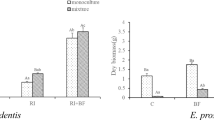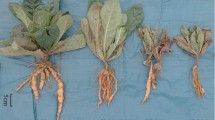Abstract
A field study of rhizoplane microfungi associated with little bluestem (Schizachyrium scoparium (Michx.) Nash), a common tallgrass prairie species, had indicated thatPenicillium chrysogenum Thom andTrichoderma harzianum Rifai outcompeted each other in unfumigated and fumigated soils, respectively. To investigate the mechanisms of competition, interactions between the two fungi were studied in laboratory experiments using an artificial model system. Mutual suppression did occur. The first-inoculated fungus was less affected. Some detrimental residual effects on the growth of one species were observed when it was grown along with the killed mass of the other in the same medium.
Similar content being viewed by others
References
Amstutz F C 1968 Applicators for methyl bromide;Down Earth Winter 15–16
Armstrong R A 1976 Fugitive species: Experiments with fungi and some theoretical considerations;Ecology 57 953–963
Bandyopadhyay P 1987Effects of soil fumigation and inorganic nutrients on root surface mycoflora of little bluestem (Schizachyrium scoparium (Michx.) Nash), Masters thesis, Illinois State University, Illinois
Brian P W 1960 Antagonistic and competitive mechanisms limiting survival and activity of fungi in soil; inEcology of soil fungi (eds) D Parkinson and J S Waid (Liverpool: University Press) pp 115–129
Cook R J and Snyder W C 1965 Influence of host exudates on growth and survival of germlings ofFusarium solani fphaseoli in soil;Phytopathology 55 1021–1025
Czachor M 1986a The occurrence of toxin-producing fungi in soil environments of selected field and grass ecosystems;Acta Agrar. Silvestria. Ser. Agrar. 24 73–84
Czachor M 1986b The effect of metabolites of selected toxin-producing fungi on some soil microorganisms and cultivated plants;Acta Agrar. Silvestria. Ser. Agrar. 24 85–94
Ebben M H, Gandy D G and Spencer D M 1983 Toxicity of methyl bromide to soil-borne fungi;Plant Pathol. 32 429–433
Fitter A H, Atkinson D, Read D J and Usher M B (eds) 1985Ecological iteractions in soil (Oxford: Blackwell)
Gandy D G and Chanter D O 1976 Some effects of time, temperature of treatment and fumigant concentration on the fungicidal properties of methyl bromide;Ann. Appl. Biol. 82 279–290
Pitt J A 1985A laboratory guide to common Penicillium species (New South Wales: Commonwealth Scientific and Industrial Research Organization, Division of Food Research)
Rifai M A 1969 A revision of the genusTrichoderma;Mycol. Pap. 116, 1–56
Rovira A D 1969 Plant root exudates;Bot. Rev. 35 35–58
Tribe H T 1966 Interactions of soil fungi on cellulose film;Trans. Br. Mycol. Soc. 47 381–391
Author information
Authors and Affiliations
Rights and permissions
About this article
Cite this article
Banerjee, P. Laboratory experiments on competition between two rhizoplane microfungiPenicillium chrysogenum andTrichoderma harzianum . Proc. Indian Acad. Sci. 100, 375–378 (1990). https://doi.org/10.1007/BF03053483
Received:
Revised:
Issue Date:
DOI: https://doi.org/10.1007/BF03053483




